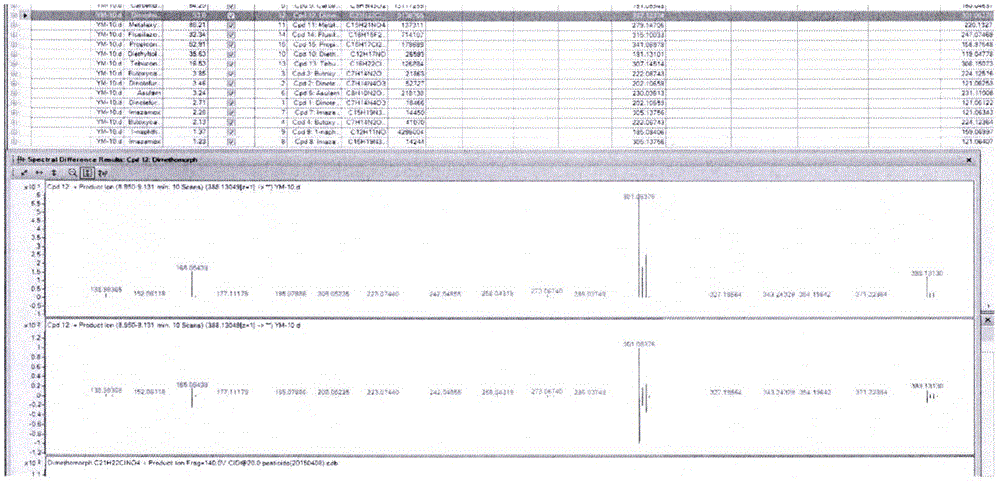LC-Q-TOF/MS detection technology for 544 pesticide residues in melon vegetables
A Q-TOF technology for melons and vegetables, applied in measuring devices, instruments, scientific instruments, etc., can solve the problems of high price, loopholes in food safety monitoring, valid period of only 2 or 3 years, etc., and achieve the effect of large amount of information
- Summary
- Abstract
- Description
- Claims
- Application Information
AI Technical Summary
Problems solved by technology
Method used
Image
Examples
Embodiment 1
[0066] An implementation example of LC-Q-TOF / MS detection and confirmation technology for 544 pesticides (see Table 1) in melon vegetables (taking cucumber as an example), including the following steps:
[0067] 1. Specific steps of sample pretreatment technology:
[0068] 1.1 Take the edible part of the cucumber sample, chop it up, mix it evenly, seal it, and mark it;
[0069] 1.2 Weigh 10g of cucumber sample (accurate to 0.01g), add 40mL of 1% acetic acid acetonitrile into an 80mL centrifuge tube, use a high-speed homogenizer at 13500r / min, homogenize and extract for 1min, add 1g of sodium chloride, 4g of anhydrous magnesium sulfate , shake for 5 min, centrifuge at 4200 r / min for 5 min, take 20 mL of the supernatant, concentrate it to about 1 mL by rotary evaporation in a 40°C water bath, and wait for purification.
[0070] 1.3 in Carbon / NH 2 Add about 2em high anhydrous sodium sulfate to the column. Rinse the SPE column with 4mL acetonitrile + toluene (3+1, v / v) first, a...
Embodiment 2
[0100] Implementation example of LC-Q-TOF / MS detection and confirmation technology for 544 pesticides (see Table 1) in melon vegetables (take zucchini as an example).
[0101] The sample pretreatment steps and LC-Q-TOF / MS operating conditions refer to the processing conditions in Example 1.
[0102] Measure the sample solution in full-scan mode, compare the detection results with the TOF database, and obtain the first-level TOF score, see Figure 4 ; For compounds whose scores meet the requirements, establish a secondary acquisition method in the software, see Figure 5 ;In MS / MS mode, re-run the sample solution to obtain the full scan data of the sample fragment ions, compare it with the fragment ion information in the MS / MS library, and obtain the secondary QTOF score, see Image 6 .
[0103] LC-Q-TOF / MS detection results of zucchini samples in a provincial capital city: 16 commercially available zucchini samples were collected in a provincial capital city, and 544 kinds o...
Embodiment 3
[0107] Implementation example of LC-Q-TOF / MS detection and confirmation technology for 544 pesticides (see Table 1) in melon vegetables (take bitter gourd as an example).
[0108] The sample pretreatment steps and LC-Q-TOF / MS operating conditions refer to the processing conditions in Example 1.
[0109] Measure the sample solution in full-scan mode, compare the detection results with the TOF database, and obtain the first-level TOF score, see Figure 7 ; For compounds whose scores meet the requirements, establish a secondary acquisition method in the software, see Figure 8 ;In MS / MS mode, re-run the sample solution to obtain the full scan data of the sample fragment ions, compare it with the fragment ion information in the MS / MS library, and obtain the secondary QTOF score, see Figure 9 .
[0110] LC-Q-TOF / MS detection results of bitter gourd samples in a provincial capital city: 7 commercially available bitter gourd samples were collected in a provincial capital city, and...
PUM
 Login to View More
Login to View More Abstract
Description
Claims
Application Information
 Login to View More
Login to View More - R&D Engineer
- R&D Manager
- IP Professional
- Industry Leading Data Capabilities
- Powerful AI technology
- Patent DNA Extraction
Browse by: Latest US Patents, China's latest patents, Technical Efficacy Thesaurus, Application Domain, Technology Topic, Popular Technical Reports.
© 2024 PatSnap. All rights reserved.Legal|Privacy policy|Modern Slavery Act Transparency Statement|Sitemap|About US| Contact US: help@patsnap.com










